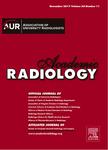版权所有:内蒙古大学图书馆 技术提供:维普资讯• 智图
内蒙古自治区呼和浩特市赛罕区大学西街235号 邮编: 010021

作者机构:Nanchang Univ Jiangxi Med Coll Sch Publ Hlth Nanchang 330006 Peoples R China Nanchang Univ Jiangxi Prov Key Lab Dis Prevent & Publ Hlth Nanchang 330006 Peoples R China Nanchang Univ Affiliated Hosp 2 Jiangxi Med Coll Dept Radiol Nanchang 330006 Peoples R China Intelligent Med Imaging Jiangxi Key Lab Nanchang 330006 Peoples R China Hubei Prov Hosp Tradit Chinese Med Dept Radiol Wuhan 430022 Peoples R China Hubei Univ Chinese Med Affiliated Hosp Wuhan 430022 Peoples R China Wanli Dist Ctr Dis Control & Prevent Nanchang Nanchang 330004 Peoples R China Jiangxi Prov Peoples Hosp Affiliated Hosp 1 Nanchang Med Coll Dept Oncol Nanchang Peoples R China Nanchang Univ Jiangxi Med Coll Nanchang Peoples R China
出 版 物:《ACADEMIC RADIOLOGY》 (Acad. Radiol.)
年 卷 期:2025年第32卷第5期
页 面:2977-2989页
核心收录:
学科分类:0831[工学-生物医学工程(可授工学、理学、医学学位)] 100207[医学-影像医学与核医学] 1006[医学-中西医结合] 1002[医学-临床医学] 1001[医学-基础医学(可授医学、理学学位)] 08[工学] 1010[医学-医学技术(可授医学、理学学位)] 100106[医学-放射医学] 1009[医学-特种医学] 10[医学] 100602[医学-中西医结合临床]
基 金:Wu Jieping Medical Foundation [320.6750.2020-10-108]
主 题:Deep learning Radiomics Feature fusion Lung adenocarcinoma Lymph node metastasis
摘 要:Rationale and Objectives: To develop and validate a multimodal deep learning (DL) model based on computed tomography (CT) images and clinical knowledge to predict lymph node metastasis (LNM) in early lung adenocarcinoma. Materials and Methods: A total of 724 pathologically confirmed early invasive lung adenocarcinoma patients were retrospectively included from two centers. Clinical and CT semantic features of the patients were collected, and 3D radiomics features were extracted from nonenhanced CT images. We proposed a multimodal feature fusion DL network based on the InceptionResNetV2 architecture, which can effectively extract and integrate image and clinical knowledge to predict LNM. Results: A total of 524 lung adenocarcinoma patients from Center 1 were randomly divided into training (n=418) and internal validation (n=106) sets in a 4:1 ratio, while 200 lung adenocarcinoma patients from Center 2 served as the independent test set. Among the 16 collected clinical and imaging features, 8 were selected: gender, serum carcinoembryonic antigen, cytokeratin 19 fragment antigen 21-1, neuron-specific enolase, tumor size, location, density, and centrality. From the 1595 extracted radiomics features, six key features were identified. The CS-RS-DL fusion model achieved the highest area under the receiver operating characteristic curve in both the internal validation set (0.877) and the independent test set (0.906) compared to other models. The Delong test results for the independent test set indicated that the CS-RS-DL model significantly outperformed the clinical model (0.844), radiomics model (0.850), CS-RS model (0.872), single DL model (0.848), and the CS-DL model (0.875) (all P 0.05). Additionally, the CS-RS-DL model exhibited the highest sensitivity (0.941) and average precision (0.642). Conclusion: The knowledge derived from clinical, radiomics, and DL is complementary in predicting LNM in lung adenocarcinoma. The integration of clinical and radiomics scores throu